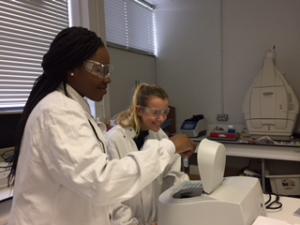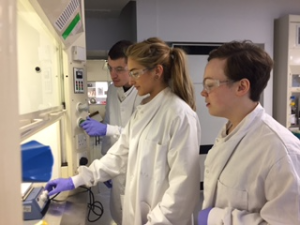A ’Blueprint’ for Peer-Based and Collaborative Learning in a Teaching Laboratory
In this post, Dr. Sweta Ladwa provides an update on her 2016 Teaching Innovation Award and explains how peer based learning can be used within a laboratory based teaching environment.
What is the problem, which you are trying address?
In a laboratory-teaching environment, students are very much focused on getting to the end product of an experiment (whether it is a compound and a form of analysis), sometimes without taking in or thinking about the steps to get to the end of the experiment. Students are normally provided with a laboratory manual, which gives detailed instructions for completing their experimental work. These instructions will include a number of ‘core’ techniques pivotal to a student’s time at university. Although the laboratory is sometimes considered to play a supporting role to the lecture in higher education, it is vital with respect to STEM subjects.
Through personal observation, when students are encouraged to discuss their knowledge to their peers in the laboratory, there is much more engagement with the material. Information is retained as knowledge is generally disseminated in their own language without necessarily using a large amount of technical jargon. This will allow students to explore the higher levels of learning objectives.
What are the objectives of the project?
- To develop a blueprint to incorporate peer-based learning of core laboratory techniques within modules in Chemistry.
- Work with students to develop and evaluate the findings from the project.
- Student-led focus groups to test and discuss the blueprint to gain wider student perspective.
How will the objectives of the project be met?
Students will be provided with a laboratory technique, which, in small groups of 2-3 students, they will evaluate research and disseminate the information back to their peers through instructional videos.
Project so far
The initial part of the project was to identify key techniques, which are considered to be fundamental to a students training within chemistry. Once identified, students were selected to carry out pilot studies in order to test the concepts outlined in the TIA. These students were selected from a group of Chemistry Student Helpers, some of whom have also been involved in the Peer Assisted Learning Scheme. Students were then split into small groups and techniques were assigned to them. They got together to plan how to disseminate the information in the form of a video and then started to put together the videos.
What did the students who were involved say about this project?
“It made me think about the techniques more’.
“I still remember what I have learnt weeks later”.
“It was a different way of learning which was enjoyable”.
Next Steps
The next steps for the project are to use student focus groups to gain feedback for the videos and this type of learning from a wider group of students. This will be carried out after the Easter break. A submission has been made and accepted to present at the RAISE conference, which is going to be held in Manchester in September 2017 during which the work will be presented. The findings will also be presented at the University’s Learning and Teaching Conference in May